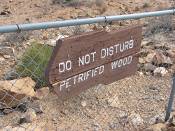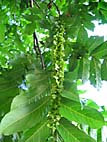Dutch treeguide at Bomengids.nl
Most common species :White birch (and Downy birch ), English oak and European beech and Red oak.
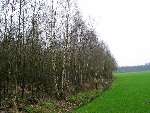
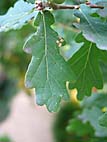
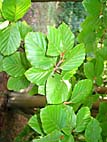
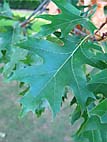
New October 2009
Mistletoo, Authum in Vaals (Netherlands), and Broceliande forest, home of Merlin in France.
How to recognize to what species a specific tree belongs?
The answer to that question is difficult. Determination can be done in lots of different ways. Often books have complex keys and systems to couple a tree to a species. Often based on leaf characteristics. I try to use the simplest and least complex way: first see if the tree fits the most simple to recognize characteristics and only if that fails try complex leaf-keys and so on: the elimination method. No need to wade though complex leaf-keys if you can see right away from the bark that you are dealing with a birch. If you do that using a leaf-key and so on will remain a little part of the search. I try to couple that method to a photo-graphical method: looking at pictures can get you a long way to the right conclusion. I do not like to use complex words if not absolutely necessary.
This site offers three ways to match a tree in the field to a species:
1. The woods-page with most common tree species.
3. Leaf-key: You can try the leaf-key here or see photographs of leaves here.
4. By flower or fruit. No keys, just photo's you can use to recognize what you see in nature.
5. Names. I offer a page here with all names of tree-species and families.
Through this page you can get to the pages per species and species-families with descriptions and above all many photographs.
Please help to improve this site: look here! Please report errors!
Main or elimination key.
1. White bark | 2. Grey bark | 3. Camouflage bark | 4. Alder bullets/mini-cones | 5. Red leaves | 6. Fruit/Wings | 7. Fruit/Ball-shaped | 8. Green round pea's | 9. Brown flat pea's | 10. Twigs and leaves hanging down | 11. Fruits hanging on a string | 12. Column-shaped tree | 13. Easy fruitsBecause some trees are easily recognized there is no need to describe such trees in detail. Let's start with trees you can easily identify:
0. This is a key for Dutch trees with leaves (hard-woods).
Four trees with needles (softwoods) are described as gymnosperms (naked-seeds): Scots pine, European larch, Dawn redwood and English yew. Later more will follow.
Furthermore I will not describe shrubs and bushes that remain lower than 10 meters. I do describe some here I describe these because they are very common where I live: European filbert, European mountainash, oneseed hawthorn, Black elderberry, Holly, smooth and Staghorn sumac.
1. Smooth and white bark.
- The bark is (mostly) smooth, shiny and white. Often with loose-hanging strips of smooth-white bark: Birch.
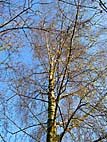 Birchfamily
Birchfamily
2. Bark is whitish/greyish, but no Birch:
-
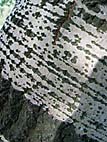 Grey or white poplar. Poplar family.
Grey or white poplar. Poplar family.
3. Bark looks like the camouflage fabric
-
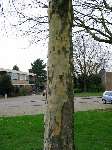 of army-clothing: light-green to yellowish patches where the bark has unlashed: Planetree.
of army-clothing: light-green to yellowish patches where the bark has unlashed: Planetree.
The Planetree has leaves as in the flag of Canada, or like a hand with fingers.
Eucaliptus has a similar bark, but does seldom grow in the Netherlands. It has long narrow leaves like willows have.
4. Alder clods/black mini-cones.
- Tree has smal roundish catkins that look like small pine-cones. These are catkins of last year.
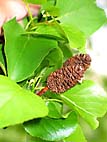 or the same cones but green (these are fresh).> Probably a kind of Alder. Ashes sometimes also have small black round balls flocking on the branches, that are actually old flowers sitting together. Alders however will probably also have hanging catkins as well, and Ashes don't. The Alder stuff also really looks like a cone, and the old flowers in the ashes do not.
or the same cones but green (these are fresh).> Probably a kind of Alder. Ashes sometimes also have small black round balls flocking on the branches, that are actually old flowers sitting together. Alders however will probably also have hanging catkins as well, and Ashes don't. The Alder stuff also really looks like a cone, and the old flowers in the ashes do not.
5. Tree has red leaves.
(In the summer).This can point to many possibilities since there are many cultivar trees that have red leaves. But possibly it is one of these:
- Is the tree really large: Red european Beech.
- Average sized tree. Some maples have red leaves on the downside, that are green on top: maple family. There are big maples (Sycamore maple) with red leaves, and smaller ones: Japanese maple.
- Pretty small tree, just bigger than a shrub: cherry plum
- Giant filbert a filbert with red leaves: a big shrub with big heart-shaped leaves with rough edges.
It goes without saying that a Beech that is young is also small, so you cannot go on size alone of course. You should compare your tree with the photos to see if leaves and so on match.
6. Wings
-
The tree has fruit in the form of "wings".
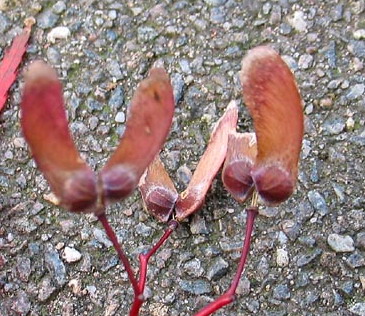 :
:
It is either a kind of Ash or a kind of Maple.
Maples
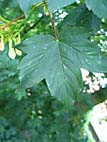 have big simple leaves, like the plane tree (photograph on the left), while Ashes have compound leaves (on the right).
have big simple leaves, like the plane tree (photograph on the left), while Ashes have compound leaves (on the right). 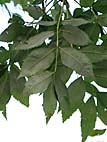
In Portugal I also saw Mimosa-like leguminosa trees with similar wings-fruit. But not in the Netherlands. This shows that any key of plants in the end is a local key. The size of the area that is alike (local) may very of course.
7. Little balls for fruit.
A tree has fruit like small balls, with stings or sting-like forms:
- Sweet chestnut or (Red) Horse chestnut
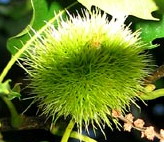
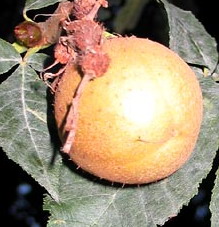 These two "chestnuts" are called the same but are no family whatsoever, by the way.
These two "chestnuts" are called the same but are no family whatsoever, by the way. - Planetree .
Easily recognized by the leaves and also the the trunk which looks like camouflage fabric or paint. Often seen in cities since they grow well in polluted air.
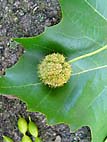
- Sweetgum .
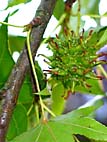 This American tree is used in the city of Nijmegen a lot. The leaves look lie maple-leaves, but he has no wings-like fruit. In stead his fruit is ball-shaped with pestle-like (look like styles of a flower) shapes around.
This American tree is used in the city of Nijmegen a lot. The leaves look lie maple-leaves, but he has no wings-like fruit. In stead his fruit is ball-shaped with pestle-like (look like styles of a flower) shapes around.
8. Tree has long round green peas
-
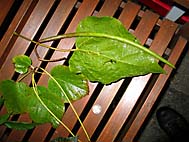 (big or very big [upto 40cm]) for fruit:
Catalpa.
(big or very big [upto 40cm]) for fruit:
Catalpa.
9. Tree has flat long brown peas:
-

- Black locust (compound leaves and long (5-10cm) thorns in pairs on the twigs) or
- other leguminosa like honeylocust (with or without thorns) or Kentucky coffeetree (branches are shaped like bones, why it is called skeleton/bones-tree in Dutch) or even other species.
10. Tree has branches and leaves that hang down like ropes.
-
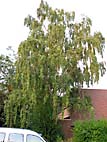 European white birch, Birchfamily , recognized by its white smooth bark.
European white birch, Birchfamily , recognized by its white smooth bark. -
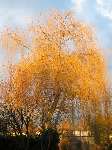 Weaping willow, often a big tree with slender long leaves usually next to a water.
Weaping willow, often a big tree with slender long leaves usually next to a water. - Many cultivars exist where species have a "weaping" form so to speak. Birches, even Beech and others.
11. Tree has its small fruits hanging down like beads on a string:
12. Tree is column-shaped.
-
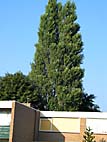 If he is really high it is often a Lombardy poplar.
If he is really high it is often a Lombardy poplar. -
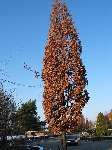 There are also column-shaped Oak and Beech. Kind of column-shaped cultivars exist and are planted in abundance in Nijmegen are European hornbeam; Musclewood; Ironwood.
There are also column-shaped Oak and Beech. Kind of column-shaped cultivars exist and are planted in abundance in Nijmegen are European hornbeam; Musclewood; Ironwood.
13. Fruit that is obvious.
Obviously some trees are best recognized by there fruit. Especially pear and apple and cherry are best recognized by the fruit. These species are so shaped by cultivation and exist of so many races that determination by other parts is often sheer impossible.
- Does he have nuts (which look like apples on the tree): Usually a Walnut
- Does he have acorns: Oak
- Does the tree bear beech-nuts? Beech
- Does he have chestnuts: Sweet chestnut (with more small nuts per fruit) or Horse chestnut with shiny-round chestnuts.
- Does he have apples.. Apple
- Pears? Pear
- Cherries... prunusfamily
- Little almost berry-sized apple-fruits? Often Whitebeam and the like. I am not always sure.
- Tree has green slender "lampoons" (green beans with a waist if you like) for fruit: Japanese scholar tree.
14. It is not there.
When you have not found your tree using the points above it might be winter? Or just a season where there is no fruit. Either that or the tree you are looking to recognize is not part of the key above. Before you delve into the leaf-key please try the following easy shortcuts from the leaf-key:- The leaf is not symmetric: the base is longer on one side than the other: Elm.
- The leaf is very small and long, yet rather small: Willow.
- Bark is very smooth, the tree is very big and leaves are rather small: Beech.
- leaves have lobes: Oak.
leaf-key
If the 14 points of the elimination key do not work, you have to find another way to determine what species a tree you find in the field is. Often the best way is to look at the shape of the tree and the leaves.
Often this might not work out though: and many books and guides do not mention things like this. Often guides and books and in-complete or even false and won't tell you what species are very difficult to spot. Books also do not tell you what tree species they do NOT mention and why. So before you begin: don't worry of you cannot exactly pin a tree down to a species: this is actually quite common.
Don't expect to be able to recognize all trees. Here are some reasons why this is often from very hard to impossible:
- Some tree-families have several species, but trees in the field are often bastards: in the files it is often very hard to see if a specific tree stands between two species, or not. The tree will have a mix of details belonging to two species. These problems are common with Birches, Oak, some poplars, Linden and Alder.
- Some species are so minimally different that leaf-differences will not help you. Often you have to look at leaf-details, or fruit and so on. This is true for Elms and Linden for instance.
- Some families, like maples and Ashes, have numerous foreign species that might be planted by people. Such species are not in the local tree-guides and thus hard to recognize. On this site you can try to find those foreign species by following links on the link page.
- Some species have many cultivar-forms. The link page has lists of cultivars so you can get an idea of how many there are. The number of such forms can be really staggering.
But if you do not try you will never win. So here you can take your shot with the leaf-key.
Sources:
1. Bomen, meer dan 130 soorten in kleur, Kenneth a. Becket, 1975 isbn 90 60743261)
2. Bomengids in kleur, Aas, Riedmiller. Thiem, 1987. isbn 9003901961
3. Flora van Nederland. Heukels Meijden. Wolters-noordhof, 1983. isbn 9001380026
4. Ons bomenland, gait l. Berk. Uniboek bv, 1976, isbn 902284911

